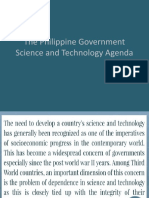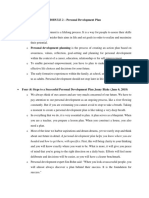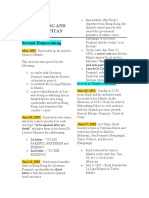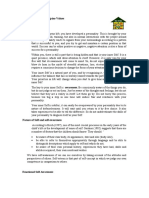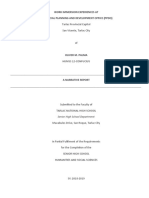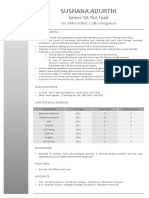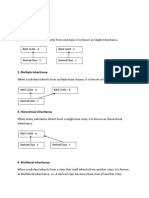Module 3
Uploaded by
24ur0427Module 3
Uploaded by
24ur0427GE 6: Science, Technology, and Society Module No.
MODULE NO. 3
SCIENCE, TENCHNOLOGY, AND NATION-BUILDING
MODULE OVERVIEW
This module will look at the role of science and technology in the evolution of Philippine society. It identifies
government programs, projects, and policies aimed at highlighting the country's scientific and technological
capabilities. This will also include discussions on indigenous science and technology in Pangasinan (Ibaloi –
San Nicolas, Kankanaey – Umingan, Badjao).
MODULE LEARNING OBJECTIVES
At the end of this Module, you should be able to:
1. Identify the contributions of Filipino scientists in science and technology;
2. Discuss the role of science and technology in Philippine nation building
3. Evaluate government policies pertaining to science and technology in terms of their contributions to
nation building
4. Identify actual science and technology policies of the government and appraise their impact on the
development of the Filipino nation
THE PHILIPPINE GOVERNMENT SCIENCE &TECHNOLOGY AGENDA
Science and Technology in the Philippines
The Philippine government initiated and implemented several programs, projects, and policies to advance
science and technology. The goal is to prepare the entire country and its people to meet the demands of a
technologically driven world, as well as to equip the people to live in a scientifically driven world.
SCIENTIST AS ADVOCATES
• Scientists and technologists are essential in a developing world. They are one of the key players in a
country's quest for industrialization. They are the lifeblood of research, innovation and have important
roles in the industry and the manufacturing sector. Together with their roles in nation-building, scientists,
too, have a responsibility to advocate for the betterment of S&T in their countries.
• For the Philippines, to halt the vicious cycle of technological backwardness and poverty, it is important
that scientists and technologists themselves be aware of the sad plight of S&T in the country and to
advocate for its improvement.
PHILIPPINE SCIENCE AND TECHNOLOGY AGENDA
The Philippines Science & Technology Agenda is one of the key players in a country's quest for
industrialization. They are the lifeblood of research, innovation and have important roles in the industry and the
manufacturing sector.
• Innovation Culture
➢ The recent success we have with the saltwater lamp, the salamander tricycle and the Diwata 1
microsatellite is a good start but only indicates that we have a long way to go before we create an
innovation culture.
➢ Innovation can only happen with enough scientists and technologists to develop an “innovation
ecosystem.”
• ASEAN Integration requires competitive technology
➢ Science and technology help us understand nature and the world and enables us to lead full lives
through new and innovative means. It therefore requires that we as Filipinos, expand our science and
technology base to enable us to compete in an integrated ASEAN.
PANGASINAN STATE UNIVERSITY 1
GE 6: Science, Technology, and Society Module No. 3
➢ Two major approaches
1. Stronger Research and Development in the regions, not just Manila
▪ Expand research and development initiatives by providing more grant support for R and D
through the DOSTs sectoral planning councils such as PCIERD, PCAARD and ASTI in
cooperation with universities in the regions.
▪ The science initiative must be distributed to the regions especially those where food production
needs to be improved, industry needs to grow and where innovation needs to be developed.
▪ This is critical in light of climate change and expensive electricity and the need to disperse
industry and economic activities.
2. Strategic projects in five areas:
▪ Renewable energy- we need new technologies to enable high electricity yields in limited space
with less dependence on natural resources to enable us to meet our COP 21 commitments,
while lowering the price of electricity.
▪ S and T for industry development- we need stronger participation of our scientists and
engineers if we want to revitalize our basic industries such as the steel industry.
▪ Faster and cheaper internet – we have Asias slowest internet, yet our archipelago needs it
bridge gaps and build networks.
▪ Increased food production- given limited lands, technology is needed to expand yields while
increasing quality of output and being less dependent on foreign inputs like fertilizers.
▪ Climate change adaptation- We need cutting edge technology to enable our farmers to adapt
to changing climates and the need to do away with technologies that destroy the capacity for
good healthful yields.
• Enabling Mechanisms and Specifics
1. More Research grants through the DOST and its sectoral planning councils and institutes
2. Strengthen the Balik Scientist Program and retention program for current young scientists- our young
scientists must be engaged through actual research projects. Many of our scientists and engineers are
OFWs who support our candidacy. We need their help to uplift our country’s technology, and we hope
they come back.
3. S and T cooperation within ASEAN- especially on the space program and climate change adaptation.
4. Cooperation between industry and the science community by involving them in the sectoral planning
councils. DOSTs programs for SMEs (Such as SET-UP) needs to be replicated further.
MAJOR DEVELOPMENT PROGRAMS AND PERSONALITIES IN S&T IN THE PHILIPPINES
Department of Science and Technology (DOST)
• The Department of Science and Technology, through the Office of the Secretary (DOST-OSEC), supervises
the Department, Attached Agencies, Councils and Institutes in the exercise of the mandate and discharge
of their powers and functions; Advises the President on matters pertaining to science & technology;
Establishes policies and standards for the operation of the Department pursuant to approved programs of
the government; Promulgates rules and regulation necessary to carry out S&T objectives, policies,
functions, plans, programs and projects; Chairs the S&T Governing Councils and the Philippine Science
High School Board of Trustees.
• DOST is responsible for formulating and adopting a comprehensive National Science and Technology Plan
for the Philippines, and to subsequently monitor and coordinate its funding and implementation.
• The DOST undertakes policy research, technology assessment, feasibility and technical studies and
maintains a national information system and databank on science and technology.
• DOST has three (3) councils (Sectoral Planning Council) - responsible for formulating policies, plans,
programs, projects and strategies for S&T development; programming and allocating funds; monitoring of
research and development projects; and generating external funds:
1. Philippine Council for Agriculture, Aquatic and Natural Resources Research and Development
(PCAARRD) - formulate policies, plans, programs, projects, and strategies for Science and Technology
(S&T) development in the agriculture, forestry, aquatic and natural resources sectors; Program and
allocate government and external funds generated for R&D efforts in the agriculture, forestry, marine
and natural resources sectors; Monitor R&D projects; and Generate external funds for its R&D activities.
PANGASINAN STATE UNIVERSITY 2
GE 6: Science, Technology, and Society Module No. 3
2. Philippine Council for Health Research and Development (PCHRD) - leads, directs and coordinates
S & T activities in the health sciences so as to improve the health and nutritional status of every Filipino.
3. Philippine Council for Industry, Energy and Emerging Technology Research and Development
(PCIEERD) - responsible for formulating strategies, policies, plans, programs and projects for advanced
S&T, industry and energy sector. It develops and implements programs for the optimal utilization,
transfer, and commercialization of technologies and other research outputs.
The Office of the Undersecretary for Research and Development provides assistance to the DOST Secretary
in the (a) supervision of the 7 DOST Research and Development Institutes, namely:
1. Advanced Science and Technology Institute (ASTI) - conducts scientific research and development
in the advanced fields of studies such as Microelectronics and Information Technology.
2. Food and Nutrition Research Institute (FNRI) - conducts research defining the citizenry’s nutritional
status, with reference particularly to the malnutrition problem, its causes and effects, and identifies
alternative solutions; develops and recommends policy options, strategies, programs and projects,
which address the malnutrition problem for implementation by the appropriate agencies; and
disseminates research findings and recommendations to the relevant end-users.
3. Forest Products Research and Development Institute (FPRDI) - conducts applied Research and
Development (R & D) on wood and non-wood forest products to generate information and technology
which can improve the utility value of wood and other forest products; transfers technologies; and,
provides technical services and training.
4. Industrial Technology Development Institute (ITDI) - undertakes applied research to develop
technologies and technological innovations in the fields of industrial manufacturing, mineral processing
and energy; undertakes the transfer of research results directly to end-users or preferably via linkage
units of other government agencies; undertakes technical services such as, but not limited to,
standards, analytical and calibrations services mandated by law or as needed by the industry; conducts
training and provides technical advisory and consultancy services to industry clientele and end-users.
5. Metals Industry Research and Development Center (MIRDC) - provides both government and
private sectors in the metals and engineering industry with professional management and technical
expertise on training of engineers and technicians, information exchange, trade accreditation services,
quality control and testing of metal products, research and development and business economics
advisory services.
6. Philippine Nuclear Research Institute (PNRI) - conducts research and development on the
application of radioisotopes and nuclear energy; undertakes transfer of research results to end-users;
operates and maintains nuclear research reactors and other radiation facilities; licenses and regulates
nuclear and radioactive substances.
7. Philippine Textile Research Institute (PTRI) - conducts applied research and development of the
textile industry; undertakes the transfer of completed researches to end-users of via linkage units of
other government agencies; and undertakes technical services and provides training services.
• It also supervises the Technology Application and Promotion Institute (TAPI). (b) Review/Formulation of
R&D policies and procedures; (c) expansion/initiation of agreements for S&T cooperation; (d) management
of DOST R&D funds; (e) management of bilateral and multilateral linkages. It also supervises the Special
Projects Division.
• The six (6) agencies (Scientific and Technological Services) - rendering science and technology-related
services are:
1. Philippine Atmospheric, Geophysical and Astronomical Services Administration (PAGASA) -
provides protection against natural calamities and utilizes scientific knowledge as an effective
instrument to ensure the safety, well-being and economic security of all the peoples.
2. Philippine Institute of Volcanology and Seismology (PHIVOLCS) - predicts the occurrence of
volcanic eruptions and earthquakes and their geotectonic phenomena; determines how eruptions and
earthquakes occur and the areas likely to be affected; exploits the positive aspects of volcanoes and
volcanic terrain in furtherance of the socio-economic development efforts of the government; generates
sufficient data for forecasting of volcanic eruptions and earthquakes; formulates appropriate disaster
preparedness plans; and mitigate hazards of volcanic activities through appropriate detection,
forecast and warning systems.
3. Philippine Science High School (PSHSS) - offers on a free scholarship basis a secondary course
with special emphasis on subjects pertaining to the sciences with the end in view of preparing its
students for a science career.
4. Science and Technology Information Institute (STII) - establishes and develops science and
PANGASINAN STATE UNIVERSITY 3
GE 6: Science, Technology, and Society Module No. 3
technology databank and library, disseminates science and technology information, and undertakes
trainings on information of science and technology.
5. Science Education Institute (SEI) - accomplishes the task of administering scholarships, awards and
grants in Science & Technology (S & T), and formulating plans for the promotion, development and
improvement of S & T education and training in order to develop a critical mass of highly trained S & T
manpower.
6. Technology Application and Promotion Institute (TAPI) - serves as the implementing arm of the
DOST in promoting the commercialization of technologies and in marketing the services of the other
operating units of the Department.
• Two (2) bodies (Collegial and Scientific Bodies) - pursue mandated functions of assistance, recognition,
advisory and establishment of international linkages.
1. National Academy of Science and Technology (NAST) - provides meaningful incentives to those
engaged in scientific and technological research, as well as gives recognition to outstanding
achievements in technology and the sciences; advises the President, Cabinet and Congress on matters
related to S & T; and embarks on programs traditionally and internationally expected of a national
academy of science.
2. National Research Council of the Philippines (NRCP) - promotes and supports fundamental or basic
research for the continuing improvement of the research capability of individual or group scientists;
fosters linkages with local and international scientific organizations for enhanced cooperation in the
development and sharing of scientific information; provides advice on problems and issues of national
interest; and promotes scientific and technological culture to all sectors of society.
• The DOST has sixteen (16) Regional Offices (ROs). Each Regional Office is headed by a Regional
Director who is under the supervision of the Undersecretary for Regional Operations. It implements laws,
rules, regulations, policies, plans, programs and projects of the Department; provides efficient S&T services
to the people in the regions; and coordinates with other government agencies and local government units
on S&T matters.
• The DOST also has eighty (80) Provincial S&T Centers (PSTCs) manned by PSTC Officers.
Philippine-American Academy of Science and Engineering (PAASE)
• The Philippine-American Academy of Science and Engineering identify several capacity building programs
such as:
1. Establishment of national centers of excellence
2. Manpower and institutional development programs
3. Establishment of regional centers to support scientific industries
4. Establishment of science and technology business centers
5. Strengthening of science education at an early age
S&T Manpower Development Programs
1. S&T Scholarship under R.A. 7687 or S&T. Scholarship Act of 1994 (S&T Scholarship Program A)
2. DOST-SEI Merit Scholarship (Formerly Project 5801 or S&T Scholarship Program B)
3. Junior Level Assistance Program (JLAP)
4. BS Scholarships in Science Education.
5. S&T Human Resource Development Planning.
DOST SCIENCE FOR CHANGE PROGRAM
• The Science for Change Program (S4CP) was created to accelerate STI in the country in order to keep up
with the developments in our time wherein technology and innovation are game changers. Through the
Science for Change Program (S4CP), the DOST can significantly accelerate STI in the country and create
a massive increase in investment on S&T Human Resource Development and R&D.
• S4CP focuses on Accelerated R&D Program for Capacity Building of R&D Institutions and Industrial
Competitiveness which is composed of four (4) programs namely:
1. Niche Centers in the Regions for R&D (NICER) Program
2. R&D Leadership (RDLead) Program
3. Collaborative R&D to Leverage PH Economy (CRADLE) for RDIs and Industry Program,
4. Business Innovation through S&T (BIST) for Industry Program.
PANGASINAN STATE UNIVERSITY 4
GE 6: Science, Technology, and Society Module No. 3
NICER PROGRAM:
RDLEAD PROGRAM:
• The R&D Leadership Program complements the establishment of R&D Centers thru the NICER
Program. RDLead provides the mechanism to bring in experts and highly skilled professionals with
strong leadership, management and innovative policy-making proficiencies to be in charge of
strengthening the research capabilities of the HEIs, National Government Agencies (NGAs) and
Research Development Institutions (RDIs) in the regions.
• Together, the RDLead and NICER Programs will capacitate HEIs to help improve and hasten the use
PANGASINAN STATE UNIVERSITY 5
GE 6: Science, Technology, and Society Module No. 3
of research results that will contribute to the socio-economic development of the country and help
address pressing challenges.
• The NRCP is the implementing agency for this programme.
CRADLE PROGRAM:
BIST PROGRAM:
• The Business Innovation through S&T (BIST) for Industry Program aims to level-up the innovation
capacity of the Philippine Industrial Sector through R&D by helping private companies and industries
acquire novel and strategic technologies, such as state-of-the-art equipment and machinery,
technology licenses and patent rights among others.
• The program will cover up to 70% of the total eligible cost of the needed technology at zero percent
interest.
The Harmonized National Research and Development Agenda (HNRDA) is divided into five (5) sectors. It
is aligned with AmBisyon Natin 2040, and is founded on the three pillars of Malasakit, Pagbabago and
Kaunlaran
Philippine Development Plan 2023-2028
• AmBisyon Natin 2040 is the twenty-five-year long term vision developed by the Philippine government as
a guide for development planning.
• It is designed to overcome the challenges brought by the Philippines' current political system, which is
bound to the limits of the country's six-year presidential terms.
• It has three pillars:
1. Malasakit (enhancing the social fabric),
2. Pagbabago (reducing inequality) and
3. Kaunlaran (increasing potential growth).
• AmBisyon Natin 2040 and the three pillars form the foundation for more inclusive growth, a high-trust and
resilient society and a globally competitive knowledge economy.
• The PDP 2023-2028 is a plan for deep economic and social transformation to reinvigorate job creation and
accelerate poverty reduction by steering the economy back on a high-growth path.
PANGASINAN STATE UNIVERSITY 6
GE 6: Science, Technology, and Society Module No. 3
• This growth must be inclusive, building an environment that provides equal opportunities to all Filipinos,
and equipping them with skills to participate fully in an innovative and globally competitive economy.
• The PDP 2023-2028 was earlier approved by the National Economic and Development Authority (NEDA)
Board, which is headed by the President, on December 16, 2022,
• President Ferdinand "Bongbong" Marcos Jr. believes that science plays a large part when it comes to the
new solutions in the new normal.
• Marcos launched a 10-point agenda as part of his vision to further boost economic growth and rejuvenate
the country's prosperity in the aftermath of the COVID-19 pandemic.
1. National Reopening
2. Public-Private Partnership
3. Infrastructure Development
4. Fiscal Discipline
5. Transparent & Efficient Governance
6. Digital Philippines
7. Energy Security
8. Future-ready Filipinos (Education)
9. Affordable Healthcare
10. Food for All
• Marcos' agenda related to science and technology includes the following:
➢ Digital Philippines- implementation of the Broadband ng Masa (BBM) program set to improve the
country's internet services.
➢ Energy Security- boost local power generation and capacity through renewable energy sources and
proper distribution.
➢ Future-ready Filipinos- provide quality education through top notch learning materials and technology
tools.
➢ Affordable Healthcare- lower cost of medicines, expand pandemic preparedness, and build regional
specialty hospitals.
➢ Food for All- increase agricultural output and improve the supply chain.
In health:
To provide medical assistance to more people, in August 2023, Marcos signed a law establishing specialty
centers in government hospitals in every region.
In agriculture:
In November 2022, Marcos expanded the Kadiwa Project launched by the Duterte administration, which aims
to offer fresh local produces to local markets and other key areas in lower prices and creates a direct farm-to-
market approach of goods and services.
The programs are located in various areas throughout the country and temporarily occupies various facilities
owned by local governments. The move is also aimed to be expanded permanently to accommodate more
consumers affected by inflation.
In education:
The Department of Education in August 2023 launched the "Matatag curriculum", a new "less congested"
curriculum for Kindergarten to Grade 10.
The new curriculum reduced the learning areas for students from seven to five and removed Mother Tongue as
a separate subject; it also emphasized a "Makabansa" learning area to instill Filipino identity
and nationalism among students.
Major Personalities in Science and Technology in the Philippines.
1. Fe Villanueva Del Mundo - She founded the first pediatric hospital in the Philippines and is known
for shaping the modern child healthcare system in the Philippines. She invented a bamboo incubator
in 1941.
PANGASINAN STATE UNIVERSITY 7
GE 6: Science, Technology, and Society Module No. 3
2. Abelardo Aguilar - lead to the discovery of the potent antibiotic Erythromycin.
3. Rolando dela Cruz - a Filipino inventor who won the gold medal for creating an anti-cancer cream
at the prestigious International Inventor’s Forum in November of 2005. It is called “DeBCC” cream and
was developed from cashew nuts and other local herbs.
4. Eduardo Quisumbing - Filipino biologist, a leading authority of plants in the Philippines.
5. Gavino C. Trono Jr. - Filipino marine biologist dubbed as the "Father of Kappaphycus farming". He
was conferred the rank of National Scientist of the Philippines for contributions to the study of tropical
marine phycology, focusing on seaweed biodiversity.
6. Maria Orasa Ylagan - Filipina food technologist, pharmaceutical chemist, humanitarian, and war
heroine. She experimented with foods native to the Philippines, and during World War II developed
Soyalac (a nutrient rich drink from soybeans) and Darak (rice cookies packed with vitamin B-1,
which prevents beriberi disease), which she also helped smuggle into Japanese-run internment
camps that helped save the lives of thousands of Filipinos, Americans, and other nationals. She
introduced to the public the well-known banana ketchup.
7. ENRIQUE MAPUA OSTREA JR. - A neonatologist who has had a substantial influence on science
and technology in the Philippines through his pioneering work on detecting prenatal exposure to drugs,
nicotine, alcohol, and environmental toxins through meconium analysis, a newborn's first stools.
8. JOSE BEJAR CRUZ JR. - He has made important contributions to the theory and practice of
automated control. His work in the 1970s and 1980s on the control of leader-follower systems is still
considered as one of the major contributions of the half-century in the theory of hierarchical control
systems. He was also named an officer of the renowned Institute of Electrical and Electronic Engineers.
9. MARI-JO PANGANIBAN RUIZ - She is well-known for her abilities as an educator and graph theorist.
10. JOSEFINO CACAS COMISO - His study has revealed the astounding rate at which Arctic Sea ice is
melting. He was a prominent figure in a global project to monitor the planet's rapidly dwindling perennial
sea ice cover, and he authored a report on the subject.
11. RAFAEL DINEROS GUERRERO III - He was recognized for his contributions to the improvement of
Sex Reversal and Hatchery Techniques, both of which help in the commercial production of high-
yielding market-size fish.
12. LILIAN FORMALEJO PATENA - She is well-known for discovering the seedless lime and pomelo
varieties, as well as doing plant biotechnology research.
13. FABIAN MILLAR DAYRIT - He is well-known for his phytochemical study on lagundi development
as part of the National Integrated Research Program on Medicinal Plants.
14. RAMON CABANOS BARBA - He is well-known for inventing floral induction in mango plants. The
significance and effect of his findings, along with his self-motivation to assist others, lead him to
transform how mangoes and other crops are produced across the world, therefore improving the life of
those who work in agriculture.
15. LOURDES JANSUY CRUZ - She is a Filipino scientist whose work has advanced our understanding
of the biochemistry of poisonous peptides derived from the venom of fish-hunting Conus marine
snails.
16. GREGORY LIGOT TANGONAN - He has played a key role in the development of optoelectronic
applications in radar, optical networking, and analog systems.
EF HISTORICAL BACKGROUND OF SCIENCE AND TECHNOLOGY IN THE PHILIPPINES:
SCIENCE EDUCATION IN THE PHILIPPINES
The Philippine Scientific Education Program is a national initiative aimed at improving science education in the
Philippines.
In the field of science education, several science-related programs and projects were created to develop
scientific literacy. These include:
• Special science classes
• Special science elementary schools
• Philippine Science High School System
• STEM track of the K-12 educational system
PICARI project - Offering basic science courses in the General Education curriculum
• The goal of science education in the Philippines is to produce scientifically literate individuals who can apply
scientific knowledge to solve community problems and make informed decisions.
• The establishment of science schools encourage students to pursue their career in science and technology
and to nurture their gifted potentials.
PANGASINAN STATE UNIVERSITY 8
GE 6: Science, Technology, and Society Module No. 3
SCIENCE SCHOOLS IN THE PHILIPPINES
• Philippine Science High School Systems (PSHSS)
➢ PSHS System education is founded on a curriculum that prioritizes science and mathematics.
➢ The PSHS System prepares students for careers in science and technology while also assisting in the
improvement of the nation.
➢ It seeks to build well-rounded individuals.
• Special Science Elementary Schools (SSES) Project
➢ It is a research and development project designed to develop students with higher aptitude for science
and mathematics through the implementation of an enhanced science and mathematics curriculum at
the elementary level.
➢ The initiative began in June 2007, SY 2007-2008 with the designation of 57 elementary schools.
• Quezon City Regional Science High School
➢ On September 17, 1967, it was known as Quezon City Science High School.
➢ It has served as the Regional Science High School since 1998.
➢ Science and technology are heavily emphasized in the curriculum.
➢ Its objective is to give as many opportunities as possible for science-gifted children to cultivate an
inquisitive and creative attitude.
• Manila Science High School
➢ The Manila Science High School was the country's first science high school.
➢ The program includes science and mathematics significantly.
➢ Its vision is to develop scientists with souls.
➢ Humanities classes and other electives are incorporated in their curriculum to accomplish this.
• Central Visayan Institute Foundation
➢ The Dynamic Learning Program (DLP) is a synthesis of classical and current pedagogical approaches
that aims to maximize learning, creativity, and productivity.
➢ It is the precursor and progenitor of the well-known Dynamic Learning program, which is a school-based
innovation.
➢ It hosts worldwide seminars to promote the exchange of ideas on cutting-edge physics and
mathematics fields.
➢ It founded the Research Center for Theoretical Physics (RCTP) in 1992.SCIENCE EDUCATION IN
THE PHILIPPINES
SELECTED INDIGEBOUS SCIENCE AND TECHNOLOGIES IN PANGASINAN (Ibaloi – San Nicolas,
Kankanaey – Umingan, Badjao)
INDIGENOUS KNOWLEDGE SYSTEM
Indigenous science
• It is a product of indigenous knowledge perfected by people through life experiences.
• It is the use of science process skills guided by community culture and values composed of
traditional/indigenous knowledge.
• Indigenous science practices in the Philippines include sustainable farming techniques like
intercropping, seed-saving, and crop variety preservation without chemical inputs, as documented
among the Matigsalog and Ata tribes.
Indigenous knowledge
• It is one that is embedded in the cultural traditions of regional, indigenous, or local communities.
• This knowledge system is passed on orally and is evident in their stories, poems, and songs.
• Note that this type of knowledge also includes superstitious beliefs and practices which may be a
product of human imagination.
Indigenous technologies
• These are processes or products resulting from studying indigenous science.
PANGASINAN STATE UNIVERSITY 9
GE 6: Science, Technology, and Society Module No. 3
• It is designed and fabricated based on the culture, tradition and needs of people and which is adopted
for use in the environment of those people
• Indigenous peoples' traditional livelihood practices such as hunting, fishing, gathering, shifting
cultivation, pastoralism, and high mountain agriculture continue to define their culture, identity and
wellbeing in addition to providing them food security.
Indigenous beliefs
• The belief Indigenous people have a strong connection to nature and have worship practices that bring
the community together.
• They usually do not have any formal teachings but seek to live in harmony with nature.
THE CONCEPT OF INDIGENOUS SCIENCE
Indigenous science is composed of traditional knowledge that uses science process skills and guided by
community values and culture.
The Ibaloi in San Nicolas, Pangasinan
• The Ibaloy are a group of people who live in houses.
• The word “I” is used as a prefix for the word ibaloy, meaning “belonging to” or “pertaining to” and “buoy,”
which means house.
• Other variants are “ibaloi,” “inibaloy,” and “nabaloi.”
• The Ibaloi are one of the indigenous peoples collectively known as Igorot, who live in Northern part of
Luzon particularly in the mountains of the Cordillera and neighboring provinces.
• The Ibaloi people were traditionally an agrarian society and many of the Ibaloi people continue with
their agriculture and rice cultivation.
• The Ibaloi language belongs to the Malayo-Polynesian branch of the Austronesian languages’ family.
• The Ibaloi language is closely related to the Pangasinan language, primarily spoken in the province of
Pangasinan, located southwest of Benguet.
• The largest feast of the Ibaloi is the Pesshet, a public feast mainly sponsored by people of prestige and
wealth. Pesshet can last for weeks and involves the killing and sacrifice of dozens of animals.
• One of the more popular dances of the Ibaloi is the Bendiyan Dance, participated in by hundreds of
male and female dancers.
• Some Ibaloi specialize in wood-carving, basket-making and weaving. Others are known for their
embroidery, appliqué and bead-making. They range from the Bontoc and Ifugaos, who built the
renowned rice terraces in the mountainous interior of Luzon, to indigenous peoples practicing shifting
cultivation or hunter-gathering..
• Ibaloi society is composed of the rich (baknang) and three poor classes, the cowhands (pastol),
farmhands (silbi), and non-Ibaloi slaves (bagaen). The Ibaloi have a rich material culture, most notably
their mummification process, which makes use of saltwater to prevent organ decomposition.
• There are Ibaloi in the municipalities: Infanta, Mabini, Sual, Bugallon, Aguilar, Laoac, Sison, San
Manuel, San Nicolas
The Kankanaey in Umingan, Pangasinan
• The name Kankanaey came from the language which they speak.
• The Kankanaey may also differ in some words like egay or aga, maid or maga. They also differ in their
ways of life and sometimes in culture.
• The Kankanaey differ in the way they dress. Women's dress of the Soft dialect has a color combination
of black, white and red. The design of the upper attire is a criss-crossed style of black, white and red
PANGASINAN STATE UNIVERSITY 10
GE 6: Science, Technology, and Society Module No. 3
colors. The skirt or tapis is a combination of stripes of black, white and red. Hard dialect women dress
is composed of mainly red and black with a little white styles, as for the skirt or tapis which is mostly
called bakget and gateng. The men wore a g-string known as a wanes for the Kanakaney's of Besao
and Sagada. The design of the wanes may vary according to social status or municipality.
• Kankanaey's major dances include tayaw, pattong, takik, a wedding dance, and balangbang. The tayaw
is a community dance that is usually done in weddings it maybe also danced by the Ibaloi but has a
different style. Pattong, also a community dance from Mountain Province which every municipality has
its own style. Balangbang is the modernized word for the word Pattong. There are also some other
dances like the sakkuting, pinanyuan (wedding dance) and bogi-bogi (courtship dance). Kankanaey
houses are built like the other Igorot houses, which reflect their social status.
• The Kankanaey are some of the best vegetable growers in the Philippines. They are innovative in the
fields and they practice proven technology like irrigation and the construction of rice terraces. Most of
their income comes from tilling the fields.
• The are also Kankanaey in the municipalities of Infanta, Dasol, Mabini, Sual, Labrador, Aguilar,
Pozorrubio, Sison, Umingan, and San Manuel.
LEARNING ACTIVITIES
The Badjao
• The largest sea tribe are the Badjao people, with an estimated population of 400,000. They are
Indigenous to The Philippines and have lived there since at least 500AD. Badjao are a fisher-folk who
have been using sustainable fishing methods for over 1500 years.
• The Badjao / Bajau tribe is an indigenous population whose culture and livelihood are tied to the sea.
Also widely known as the “Sea Gypsies” of the Sulu and Celebes Seas, the Badjao are scattered along
the coastal areas of Tawi Tawi, Sulu, Basilan, and some coastal areas of Zamboanga City.
• The Badjao are an indigenous group in the Philippines, known as sea nomads.
REFERENCES
• Serafica, JPJ, Pawilen, GT, Caslib, Jr., BN, Alata, EJP (2018) Science, Technology, and Society. pp 21-48. Quezon
City: Rex Book Store, Inc.
• Quinto, Edward Jay M. and Nieva, Aileen D. (2019). Science, Technology, and Society. pp 59-60. Quezon City: C&E
Publishing.
• https://www.dost.gov.ph/
PANGASINAN STATE UNIVERSITY 11
You might also like
- Nism X A - Investment Adviser Level 1 - Last Day Revision Test 3 PDF40% (5)Nism X A - Investment Adviser Level 1 - Last Day Revision Test 3 PDF42 pages
- Cebu Technological University: Republic of The Philippines Danao CampusNo ratings yetCebu Technological University: Republic of The Philippines Danao Campus6 pages
- Chapter 5: Revouitionizing Human Life Breakthrough in Science and TechnologyNo ratings yetChapter 5: Revouitionizing Human Life Breakthrough in Science and Technology10 pages
- Accomplishments and Contributions of The Different Administrations To Science, Technology and Education During Their Term100% (1)Accomplishments and Contributions of The Different Administrations To Science, Technology and Education During Their Term6 pages
- GE 104 - Mathematics in The Modern World: FIRST Semester, AY 20201-2022 I. Course Code/ Title: II. Subject MatterNo ratings yetGE 104 - Mathematics in The Modern World: FIRST Semester, AY 20201-2022 I. Course Code/ Title: II. Subject Matter13 pages
- Science, Technology, and Nation BuildingNo ratings yetScience, Technology, and Nation Building19 pages
- 001 - Human Flourishing in Science and TechnologyNo ratings yet001 - Human Flourishing in Science and Technology24 pages
- 2 GE 5 Chapter 7 When Technology & Humanity CrossNo ratings yet2 GE 5 Chapter 7 When Technology & Humanity Cross12 pages
- Chapter 3: Science and Technology and Nation Building OverviewNo ratings yetChapter 3: Science and Technology and Nation Building Overview14 pages
- Chapter II Lesson 1 The Philippine Government Science and Technology AgendaNo ratings yetChapter II Lesson 1 The Philippine Government Science and Technology Agenda16 pages
- Soc101 - Activity 2 (The Structures of Globalization) SacuratNo ratings yetSoc101 - Activity 2 (The Structures of Globalization) Sacurat3 pages
- Lesson 5 - The Philippine Government Science and Technology Agenda100% (1)Lesson 5 - The Philippine Government Science and Technology Agenda17 pages
- Science and Technology During The Philippine IndependenceNo ratings yetScience and Technology During The Philippine Independence26 pages
- Franklien Jay Matutina - Activity 2 Determining Appropriate BehaviorNo ratings yetFranklien Jay Matutina - Activity 2 Determining Appropriate Behavior1 page
- Media and Information Literacy: Quarter 3 - Module 2, Week 2100% (1)Media and Information Literacy: Quarter 3 - Module 2, Week 219 pages
- Unit 2: Science, Technology, Society, and The Human Condition Chapter 4: HUMAN FLOURISHING in Science and TechnologyNo ratings yetUnit 2: Science, Technology, Society, and The Human Condition Chapter 4: HUMAN FLOURISHING in Science and Technology5 pages
- Sts Lecture 3 - Middle Ages, Modern Times, Philippine InventionsNo ratings yetSts Lecture 3 - Middle Ages, Modern Times, Philippine Inventions31 pages
- National Policies That Address The Ethical and Moral Concerns in The Technological EraNo ratings yetNational Policies That Address The Ethical and Moral Concerns in The Technological Era6 pages
- Science and Technology in The PhilippinesNo ratings yetScience and Technology in The Philippines25 pages
- March 29, 1521 (Holy Friday) : The CaptainNo ratings yetMarch 29, 1521 (Holy Friday) : The Captain4 pages
- I. Topic: Assumptions and Nature of ArtsNo ratings yetI. Topic: Assumptions and Nature of Arts15 pages
- The Colonial Era: Readings in Philippine HistoryNo ratings yetThe Colonial Era: Readings in Philippine History6 pages
- Ge 7: Science, Technology and Society: University of Eastern Philippines0% (1)Ge 7: Science, Technology and Society: University of Eastern Philippines20 pages
- Contribution of Spaniards and American To The Development of Science and TechnologyNo ratings yetContribution of Spaniards and American To The Development of Science and Technology3 pages
- Chapter 2: Historical Antecedents of Science and Intellectual Revolutions That Defined SocietyNo ratings yetChapter 2: Historical Antecedents of Science and Intellectual Revolutions That Defined Society27 pages
- ACTIVITY 1. Preparing Your Research Plan DIRECTIONS: Choose A Research Topic Listed Inside The Box and Complete The TableNo ratings yetACTIVITY 1. Preparing Your Research Plan DIRECTIONS: Choose A Research Topic Listed Inside The Box and Complete The Table6 pages
- Work Immersion Experiences at Provincial Planning and Development Office (Ppdo)No ratings yetWork Immersion Experiences at Provincial Planning and Development Office (Ppdo)27 pages
- Understanding The Self (GEED 10023) : Santa Rosa CampusNo ratings yetUnderstanding The Self (GEED 10023) : Santa Rosa Campus27 pages
- SELF According To Filipino Culture ActivityNo ratings yetSELF According To Filipino Culture Activity6 pages
- San Miguel Village, Pala-O, Iligan City: Iligan Medical Center CollegeNo ratings yetSan Miguel Village, Pala-O, Iligan City: Iligan Medical Center College3 pages
- The Role of Science and Technology in Philippine Nation BuildingNo ratings yetThe Role of Science and Technology in Philippine Nation Building19 pages
- Chapter 3: Water Pollution: Introduction (1, p.187)No ratings yetChapter 3: Water Pollution: Introduction (1, p.187)32 pages
- An Integration of GIS and Remote Sensing in GroundNo ratings yetAn Integration of GIS and Remote Sensing in Ground10 pages
- Workers' Organization Development Program (Wodp) Dole-NcrNo ratings yetWorkers' Organization Development Program (Wodp) Dole-Ncr15 pages
- Assessing and Testing Hydrokinetic Turbine Performance and Effects On Open Channel Hydrodynamics - An Irrigation Canal Case StudyNo ratings yetAssessing and Testing Hydrokinetic Turbine Performance and Effects On Open Channel Hydrodynamics - An Irrigation Canal Case Study40 pages
- Diana Hernandez Cruz - North-South Dispute Over Slavery Led To Civil War - Student PacketNo ratings yetDiana Hernandez Cruz - North-South Dispute Over Slavery Led To Civil War - Student Packet4 pages
- Was That Supposed To Be Funny - A Rhetorical Analysis of Politics PDFNo ratings yetWas That Supposed To Be Funny - A Rhetorical Analysis of Politics PDF181 pages
- Masterlist of Enrolled Learners With End of Program/Cy Status (Af-3)No ratings yetMasterlist of Enrolled Learners With End of Program/Cy Status (Af-3)4 pages
- Opposer Information: Notice of OppositionNo ratings yetOpposer Information: Notice of Opposition19 pages
- Compensation Management: Performance and Reward Management Kmbnhr04No ratings yetCompensation Management: Performance and Reward Management Kmbnhr0419 pages
- Nism X A - Investment Adviser Level 1 - Last Day Revision Test 3 PDFNism X A - Investment Adviser Level 1 - Last Day Revision Test 3 PDF
- Cebu Technological University: Republic of The Philippines Danao CampusCebu Technological University: Republic of The Philippines Danao Campus
- Chapter 5: Revouitionizing Human Life Breakthrough in Science and TechnologyChapter 5: Revouitionizing Human Life Breakthrough in Science and Technology
- Accomplishments and Contributions of The Different Administrations To Science, Technology and Education During Their TermAccomplishments and Contributions of The Different Administrations To Science, Technology and Education During Their Term
- GE 104 - Mathematics in The Modern World: FIRST Semester, AY 20201-2022 I. Course Code/ Title: II. Subject MatterGE 104 - Mathematics in The Modern World: FIRST Semester, AY 20201-2022 I. Course Code/ Title: II. Subject Matter
- Chapter 3: Science and Technology and Nation Building OverviewChapter 3: Science and Technology and Nation Building Overview
- Chapter II Lesson 1 The Philippine Government Science and Technology AgendaChapter II Lesson 1 The Philippine Government Science and Technology Agenda
- Soc101 - Activity 2 (The Structures of Globalization) SacuratSoc101 - Activity 2 (The Structures of Globalization) Sacurat
- Lesson 5 - The Philippine Government Science and Technology AgendaLesson 5 - The Philippine Government Science and Technology Agenda
- Science and Technology During The Philippine IndependenceScience and Technology During The Philippine Independence
- Franklien Jay Matutina - Activity 2 Determining Appropriate BehaviorFranklien Jay Matutina - Activity 2 Determining Appropriate Behavior
- Media and Information Literacy: Quarter 3 - Module 2, Week 2Media and Information Literacy: Quarter 3 - Module 2, Week 2
- Unit 2: Science, Technology, Society, and The Human Condition Chapter 4: HUMAN FLOURISHING in Science and TechnologyUnit 2: Science, Technology, Society, and The Human Condition Chapter 4: HUMAN FLOURISHING in Science and Technology
- Sts Lecture 3 - Middle Ages, Modern Times, Philippine InventionsSts Lecture 3 - Middle Ages, Modern Times, Philippine Inventions
- National Policies That Address The Ethical and Moral Concerns in The Technological EraNational Policies That Address The Ethical and Moral Concerns in The Technological Era
- Ge 7: Science, Technology and Society: University of Eastern PhilippinesGe 7: Science, Technology and Society: University of Eastern Philippines
- Contribution of Spaniards and American To The Development of Science and TechnologyContribution of Spaniards and American To The Development of Science and Technology
- Chapter 2: Historical Antecedents of Science and Intellectual Revolutions That Defined SocietyChapter 2: Historical Antecedents of Science and Intellectual Revolutions That Defined Society
- ACTIVITY 1. Preparing Your Research Plan DIRECTIONS: Choose A Research Topic Listed Inside The Box and Complete The TableACTIVITY 1. Preparing Your Research Plan DIRECTIONS: Choose A Research Topic Listed Inside The Box and Complete The Table
- Work Immersion Experiences at Provincial Planning and Development Office (Ppdo)Work Immersion Experiences at Provincial Planning and Development Office (Ppdo)
- Understanding The Self (GEED 10023) : Santa Rosa CampusUnderstanding The Self (GEED 10023) : Santa Rosa Campus
- San Miguel Village, Pala-O, Iligan City: Iligan Medical Center CollegeSan Miguel Village, Pala-O, Iligan City: Iligan Medical Center College
- The Role of Science and Technology in Philippine Nation BuildingThe Role of Science and Technology in Philippine Nation Building
- Chapter 3: Water Pollution: Introduction (1, p.187)Chapter 3: Water Pollution: Introduction (1, p.187)
- An Integration of GIS and Remote Sensing in GroundAn Integration of GIS and Remote Sensing in Ground
- Workers' Organization Development Program (Wodp) Dole-NcrWorkers' Organization Development Program (Wodp) Dole-Ncr
- Assessing and Testing Hydrokinetic Turbine Performance and Effects On Open Channel Hydrodynamics - An Irrigation Canal Case StudyAssessing and Testing Hydrokinetic Turbine Performance and Effects On Open Channel Hydrodynamics - An Irrigation Canal Case Study
- Diana Hernandez Cruz - North-South Dispute Over Slavery Led To Civil War - Student PacketDiana Hernandez Cruz - North-South Dispute Over Slavery Led To Civil War - Student Packet
- Was That Supposed To Be Funny - A Rhetorical Analysis of Politics PDFWas That Supposed To Be Funny - A Rhetorical Analysis of Politics PDF
- Masterlist of Enrolled Learners With End of Program/Cy Status (Af-3)Masterlist of Enrolled Learners With End of Program/Cy Status (Af-3)
- Compensation Management: Performance and Reward Management Kmbnhr04Compensation Management: Performance and Reward Management Kmbnhr04
























